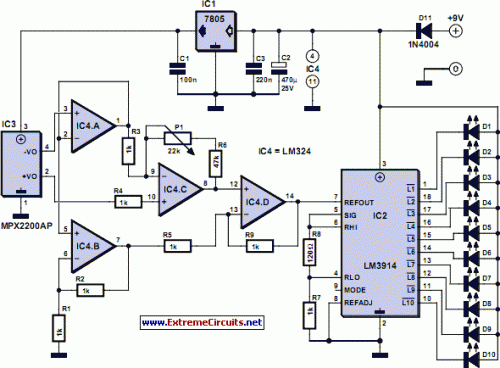Electronic Torricelli Barometer
Circuit diagram:
Description
Although it does not have the same charm as real mercury barometers with long glass tubes on pieces of carved and polished wood, the Torricelli barometer discussed here is a functional equivalent and electronic replica of the Torricelli barometer. Actually, rather than displaying the atmospheric pressure on the traditional digital displays, we preferred to reproduce the general look of this respected predecessor of electronic barometers.
The mercury tube is, of course, replaced by a simple LED scale which, if not as beautiful, is still less toxic for the environment in case of breakage. As indicated on the drawing, the pressure sensor utilized is a Motorola MPX2200AP. This circuit is adapted for measuring absolute pressure and has a range well suited for atmospheric pressure. Without entering too deep into the technical details, such sensors deliver an output of voltage proportional not only to the measured pressure but, unfortunately, to their supply voltage as well.
Hence they must be powered from a stable voltage which is ensured here by the use of IC1. Since the output of the MPX2200 is differential and at a very low level, we had to resort to the use of four operational amplifiers IC4.A to IC4.D, contained in one LM324, to obtain levels that can be processed easily. As long as potentiometer P1 is adjusted correctly, this group of operational amplifiers delivers a voltage of 1 volt per atmospheric pressure of 1,000 hPa to the LM3914.
Since the atmospheric pressure will be within the range 950 to 1040 hPa at sea level, we need to make an expanded-scale voltmeter with this LM3914 in order to better exploit the 10 LEDs that it can control. That is the role of resistors R7 and R8 which artificially raise the minimum voltage value the chip is capable of measuring. Consequently, we can ‘calibrate’ our LED scale with one LED per 10 hPa and thus benefit from a measurement range which extends from 950 hPa to 1040 hPa. In principle, you should not have a need to go beyond that in either direction.
The circuit may be conveniently powered from a 9-volt battery but only if used very occasionally. Since this is usually not the case for a barometer, we advise you to use a mains adaptor instead supplying approximately 9 volts. Calibration basically entails adjusting the potentiometer P1 to light the LED corresponding to the atmospheric pressure of your location at the time. Compare with an existing barometer or, even better, telephone the closest weather station. They will be happy to give you the information. After Evangelista Torricelli, 1608-1647, Italian physician who proved the existence of atmospheric pressure and invented the mercury barometer.
